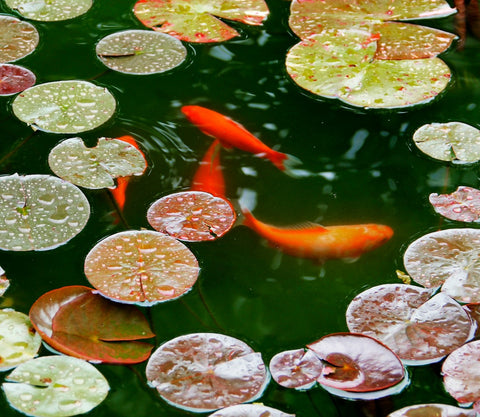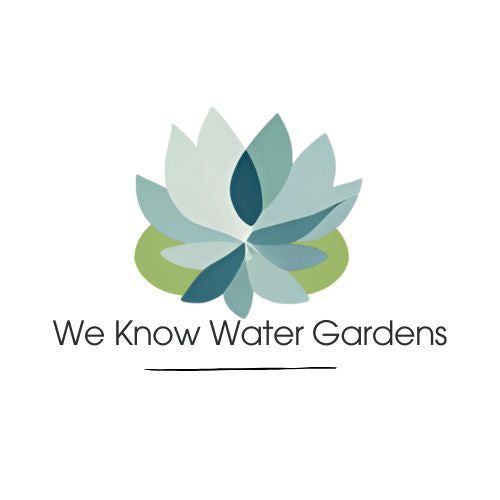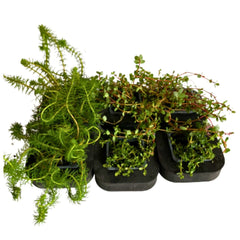Home
>
We Know Water Gardens Blog
>
Clear Pond Water: How to Achieve a Clear Pond All Year Round in Australia
Clear Pond Water: How to Achieve a Clear Pond All Year Round in Australia
on Feb 14, 2024

Are you frustrated by the murky water in your pond? Extremes of heat, cold, and humidty across Australia can make it difficult to keep pond water clear but the good news is that it is possible! In this article, we will provide you with expert tips and techniques on how to achieve a clear pond that will become a focal point for all the right reasons.
Maintaining clear pond water can be a challenging task, but with the right knowledge and guidance, you can achieve successful results. From understanding the role of filtration systems to implementing effective algae control methods, we will cover everything you need to know to keep your pond water crystal clear.
Whether you have a small backyard pond or a large koi pond, our step-by-step guide will help you overcome common issues such as green water, algae blooms, and excess debris and other issues experienced in Australia. We will also share some insider secrets on how to prevent future problems and keep your pond looking its best.
Importance of Pond Water Clarity
 Having a clear pond not only enhances the visual appeal but also promotes a healthy ecosystem for your aquatic life. Clear water allows you to see and appreciate the natural beauty of your fish, plants, rocks and other pond inhabitants. It also creates a tranquil and inviting environment that you can enjoy year-round.
Having a clear pond not only enhances the visual appeal but also promotes a healthy ecosystem for your aquatic life. Clear water allows you to see and appreciate the natural beauty of your fish, plants, rocks and other pond inhabitants. It also creates a tranquil and inviting environment that you can enjoy year-round.
In addition to the aesthetic benefits, clear pond water is essential for the overall health and well-being of your aquatic life. Murky water can hinder the growth of plants, disrupt the balance of oxygen and carbon dioxide, and deprive your fish of the necessary sunlight for photosynthesis. By maintaining clear water, you provide a conducive habitat for your pond inhabitants to thrive and deter those you don't want such as mosquitos.
Common Causes of Cloudy Pond Water
Before diving into the solutions, it's important to understand the common causes of cloudy pond water. This knowledge will help you identify the root cause of the problem and implement targeted solutions accordingly. Here are some of the main culprits behind cloudy pond water:
- Excessive nutrients: Overfeeding your fish or using low-quality fish food can lead to an excess of nutrients in the water. These nutrients act as food for algae and other microorganisms, contributing to the cloudiness of the pond.
- Algae blooms: Algae are microscopic plants that thrive in the presence of sunlight and nutrients. When the conditions are favorable, algae can multiply rapidly, turning your pond water green or brown.
- Suspended particles: Fine particles such as sediment, debris, and fish waste can remain suspended in the water, causing it to appear cloudy or murky. These are easy to remedy!
- Lack of filtration: Inadequate filtration or a malfunctioning filtration system can result in poor water quality and clarity. Without proper filtration, the water cannot be effectively purified, leading to cloudiness.
Understanding these causes will help you address the specific issues affecting your pond and take appropriate measures to achieve clear water.
Understanding Pond Filtration Systems
 One of the key components in achieving and maintaining clear pond water is a reliable filtration system. Pond filtration systems are designed to remove impurities, debris, and excess nutrients from the water, ensuring optimal water quality and clarity. Understanding how filtration systems work will help you select the right one for your pond.
One of the key components in achieving and maintaining clear pond water is a reliable filtration system. Pond filtration systems are designed to remove impurities, debris, and excess nutrients from the water, ensuring optimal water quality and clarity. Understanding how filtration systems work will help you select the right one for your pond.
There are three main types of pond filtration systems:
- Mechanical filtration: This type of filtration physically removes debris and particles from the water. It typically consists of filters with fine mesh or foam pads that trap solid waste as the water passes through.
- Biological filtration: Biological filtration makes use of beneficial bacteria to break down harmful substances and convert them into less harmful compounds. This process helps maintain a healthy balance in the pond ecosystem and promotes water clarity.
- Ultra Violet Clarifiers: UVC, sometimes referred to as UV sterilisers use ultraviolet light to kill algae and other microorganisms, preventing them from reproducing and causing water clarity issues. This type of filtration is particularly effective in controlling green water caused by algae blooms. Learn more here about UVC's: The Ultimate Guide to Ultra Violet Clarifiers: Enhancing Pond Health and Beauty
Each filtration system has its own advantages and limitations, and the ideal choice depends on the size of your pond, the type of aquatic life you have, and your specific water quality concerns.
Choosing the Right Filtration System for Your Pond
Selecting the right filtration system for your pond is crucial for achieving and maintaining clear water. Consider the following factors when choosing a filtration system:
- Pond size: The size of your pond will determine the capacity and strength of the filtration system you need. Larger ponds generally require more powerful filtration systems to effectively circulate and filter the water.
- Fish population: If you have a large number of fish in your pond, you will need a filtration system that can handle the increased waste production. Fish produce waste, which can contribute to poor water quality if not properly filtered.
- Plant life: The presence of aquatic plants can help naturally filter the water by absorbing excess nutrients and providing oxygen. However, if you have a dense population of plants, you may need a filtration system that can handle the additional organic matter they produce.
- Water features: Ponds with waterfalls, fountains, or other water features may require specialised filtration systems to ensure proper circulation and filtration.
By considering these factors, you can make an informed decision and choose a filtration system that is tailored to your pond's specific needs. Always feel free to contact us and we can assist you with what will work best for your pond, in your region of Australia.
Proper Maintenance for Clear Pond Water
 Once you have installed a suitable filtration system, proper maintenance is essential to ensure clear pond water all year round. Regular maintenance tasks help prevent the buildup of debris, excess nutrients, and algae that can compromise water clarity. Here are some maintenance tips to keep in mind:
Once you have installed a suitable filtration system, proper maintenance is essential to ensure clear pond water all year round. Regular maintenance tasks help prevent the buildup of debris, excess nutrients, and algae that can compromise water clarity. Here are some maintenance tips to keep in mind:
- Regular cleaning: Clean your filtration system regularly to remove any trapped debris or waste. This will prevent clogs and ensure optimal filtration performance.
- Monitor water parameters: Regularly test the water for pH, ammonia, nitrite, and nitrate levels. These parameters can provide valuable insights into the overall health of your pond and help you address any potential issues before they become major problems.
- Remove excess debris: Skim the surface of the water and remove any floating debris using a pond net or skimmer. This will prevent the accumulation of organic matter that can contribute to water cloudiness.
- Trim and thin plants: Overgrown or dying plants can release excess nutrients into the water, leading to algae blooms. Regularly trim and thin out your aquatic plants to prevent nutrient overload.
By incorporating these maintenance practices into your routine, you can ensure that your filtration system operates efficiently and your pond water remains clear and inviting.
Using Beneficial Bacteria to Maintain Water Clarity
Beneficial bacteria play a crucial role in maintaining water clarity and overall pond health. These bacteria break down organic matter, fish waste, and excess nutrients, preventing their accumulation in the water. By adding beneficial bacteria to your pond, you can promote a healthy balance and reduce the likelihood of water clarity issues.
There are two main types of beneficial bacteria used in pond maintenance:
- Nitrifying bacteria: Nitrifying bacteria convert harmful ammonia produced by fish waste into less toxic nitrites and nitrates. These bacteria colonise in the filtration system and help break down these compounds, promoting water clarity and preventing fish stress.
-
Sludge-reducing bacteria: Sludge-reducing bacteria such as API's EcoFix Sludge Destroyer, targets the organic
 matter that accumulates at the bottom of the pond. They break down this debris, reducing the nutrient load and preventing the formation of algae blooms.
matter that accumulates at the bottom of the pond. They break down this debris, reducing the nutrient load and preventing the formation of algae blooms.
Adding beneficial bacteria to your pond is a simple and effective way to improve water quality. Follow the manufacturer's instructions for dosage and application, and regularly replenish the bacteria to maintain their population.
Controlling Algae and Other Aquatic Plants
Algae growth is one of the most common causes of water cloudiness in ponds. While some algae are beneficial and necessary for a healthy ecosystem, excessive algae can lead to green or brown water and diminish the visual appeal of your pond. Implementing effective algae control methods is crucial for maintaining water clarity. Here are some strategies to consider:
- Shade and sunlight control: Algae thrive in the presence of sunlight. By providing shade with plants, pond covers, or strategically placed structures, you can limit the amount of sunlight that reaches the water surface, inhibiting algae growth.
- Algaecides and herbicides: Chemical treatments can be used to control algae and other unwanted aquatic plants. However, it's important to use these products sparingly and according to the manufacturer's instructions to avoid harming beneficial organisms and disrupting the pond ecosystem. Incorporate products such as API's Pond Simply Clear with Barley. When used as directed API Pond Simply Clear is safe for fish and plants and can be used in all types of water gardens, water features and ponds.
- Algae-eating fish: Introducing certain species of fish, such as koi or Australian native catfish, can help control algae growth. Even tadpoles will eat some algae and are a sign of a healthy pond! These fish feed on algae, keeping their population in check and preventing excessive blooms. For Aussie ponds, we recommend species like Murray River Rainbow, Golden Medaka, Whitecloud, Silver Perch, and Tandanus Catfish. Warmer regions allow for the inclusion of various native species, especially Rainbowfish, which thrive in pond setups.
- Mechanical removal: If you have a small pond or a localised algae problem, manually removing the algae using a pond net or rake can be effective. It can be added to your home compost system if you have one. Regularly skim the surface and remove any visible algae to prevent it from spreading.
By combining these strategies and customising them to your specific pond conditions, you can effectively control algae growth and maintain clear water.
The Role of Oxygenation in Pond Water Clarity
Oxygenation is a critical factor in maintaining water clarity and promoting a healthy pond environment. Adequate oxygen levels are essential for the survival of fish, plants, and beneficial bacteria, and help prevent the accumulation of organic matter that can contribute to water cloudiness. Here's how you can ensure proper oxygenation in your pond:
- Aeration: Aeration is the process of adding oxygen to the water. This can be achieved through the use of pond pumps, diffusers, fountains, or waterfalls. Aeration helps circulate the water, improving oxygen exchange and preventing stagnation.
- Plants: Oxygenating Pond Plants play a vital role in oxygenation by releasing oxygen during photosynthesis. They also absorb excess carbon dioxide, helping to maintain a healthy balance in the water. Consider plants such as Brahmi (Bacopa Monnieri) and Water Hyssop (Bacopa caroliniana).
- Fish population management: Overcrowding your pond with fish can lead to oxygen depletion, especially during hot summer months when oxygen levels naturally decrease. Regularly monitor your fish population and consider removing or relocating some fish if necessary.
By ensuring proper oxygenation, you create an environment that supports clear water and the overall well-being of your pond ecosystem.
Addressing Common Pond Water Problems
 Despite your best efforts, you may encounter occasional challenges in maintaining clear pond water. Understanding and addressing these common problems promptly will help you restore water clarity and prevent further issues. Here are some common pond water problems and their solutions:
Despite your best efforts, you may encounter occasional challenges in maintaining clear pond water. Understanding and addressing these common problems promptly will help you restore water clarity and prevent further issues. Here are some common pond water problems and their solutions:
- Green water: Green water is caused by excessive algae growth, often become worse in summer. To combat this issue, implement algae control methods such as shade, algaecides, and algae-eating fish. Ensure that your filtration system is equipped to handle the increased algae load and consider adding an Ultra Violet Clarifier for effective control.
-
Murky water: Murky water is often caused by suspended particles and
 debris. Increase mechanical filtration by cleaning or upgrading your filtration system. Regularly remove excess debris from the surface of the water and consider using flocculants or water clarifiers to help settle suspended particles. Ensure you apply API's Pond Accu Clear to the pond during this process. This will bind together particles that cause murky water and allow them to settle on the bottom of your pond.
debris. Increase mechanical filtration by cleaning or upgrading your filtration system. Regularly remove excess debris from the surface of the water and consider using flocculants or water clarifiers to help settle suspended particles. Ensure you apply API's Pond Accu Clear to the pond during this process. This will bind together particles that cause murky water and allow them to settle on the bottom of your pond.
- Foamy water: Foamy water is usually a result of excessive organic matter or detergents entering the pond. Identify and eliminate the source of contamination. Increase aeration and consider adding sludge-reducing bacteria to break down the organic matter.
- Excessive debris: If your pond is constantly accumulating debris, consider using a PondoVac to make this job a breeze, especially for larger ponds. Learn more about PondoVacs here: The Ultimate Guide to Choosing the Best Pond Vacuum
By proactively addressing these issues and implementing targeted solutions, you can maintain clear pond water and enjoy the beauty of your pond all year round.
Enjoying a Clear and Beautiful Pond All Year Round
Don't let murky water ruin the beauty of your pond any longer. By following the expert tips and techniques outlined in this article, you can achieve and maintain clear pond water that will impress both you and your guests. From understanding the importance of pond water clarity to selecting the right filtration system, implementing proper maintenance practices, and controlling algae, you now have the knowledge and tools to transform your pond into a stunning centerpiece.
Remember to regularly monitor and adjust your pond's conditions to ensure optimal water quality. By taking proactive measures and addressing any issues promptly, you can enjoy a clear and captivating pond all year round. With a little effort and the right strategies, you can turn your dream of a clear and pristine pond into a reality.
© weknowwatergardens 2024
Share


